stop start AUDI A3 CABRIOLET 2015 Owner's Guide
[x] Cancel search | Manufacturer: AUDI, Model Year: 2015, Model line: A3 CABRIOLET, Model: AUDI A3 CABRIOLET 2015Pages: 302, PDF Size: 73.83 MB
Page 201 of 302
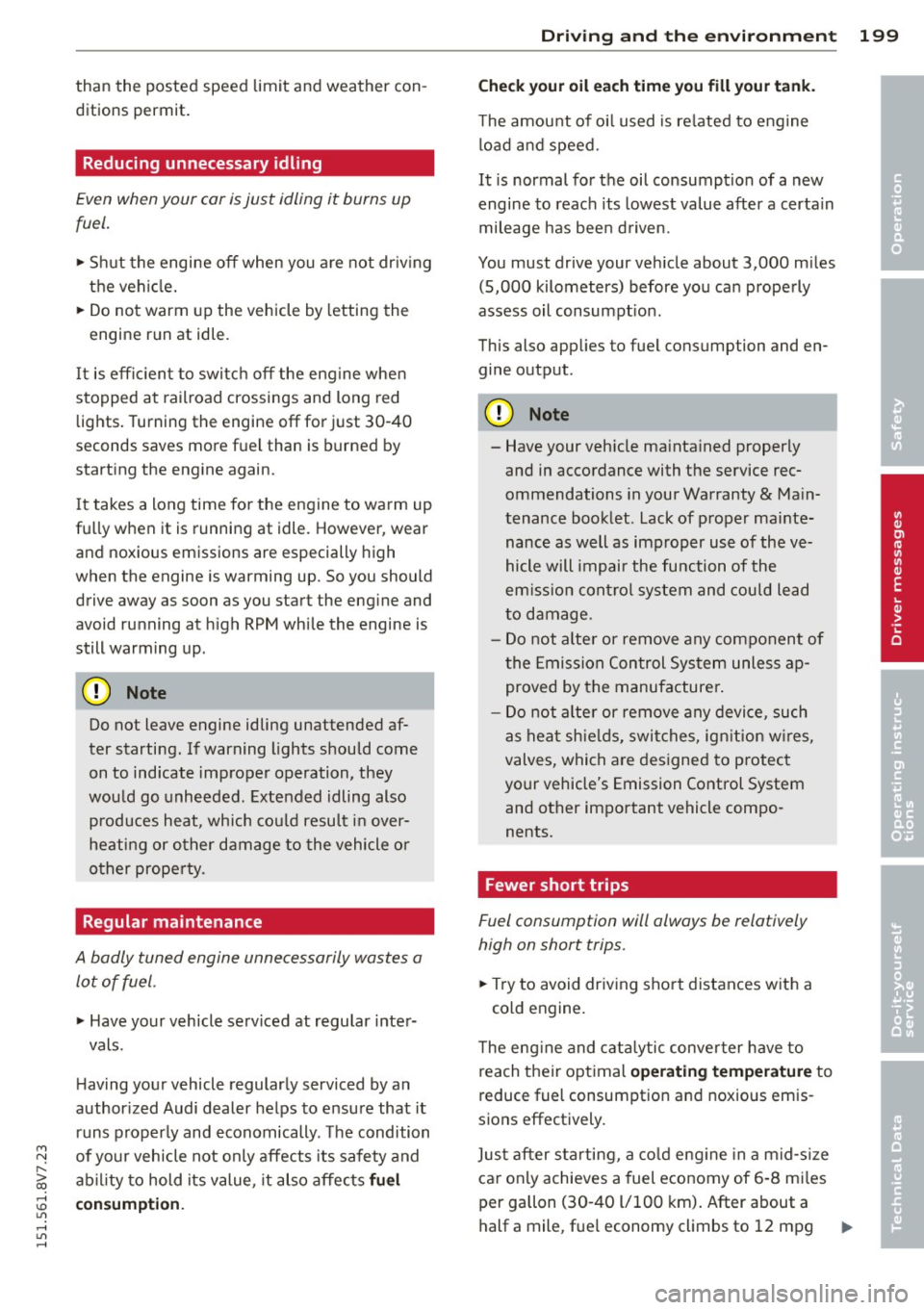
M N
" > co ...... \!) 1.1'1
...... 1.1'1 ......
than the posted speed limit and weather con
ditions permit. Reducing unnecessary idling
Even wh en your car is just idling it burns up
fuel.
.,. Shu t the engine off when you a re not dr iv ing
the vehi cle.
... Do not warm up the vehicle by letting the
engine run at idle.
It is effic ient to switch off the eng ine when
stopped at railroad crossings and long red
lights. Turning the engine
off for just 30-40
seconds saves more fu el than is burned by
starting the engine again.
It takes a long time fo r the engine to wa rm up
fu lly when it is running at idle. However , wear
and noxious emissions are especially high
when the engine is wa rming up. So you should
drive away as soon as you start the eng ine and
avoid running at h igh RPM while the engine is
still warm ing up.
Do not leave engine idling unattended af
ter starting. If warning lights should come on to indicate improper operation, they
wou ld go unheeded. Extended idling also
p roduces heat, which cou ld result in over
heating or other damage to the vehicle or
other prope rty .
Regular maintenance
A badly tuned engine unnecessarily wastes a lot of fuel.
.,. Have your vehicle serv iced at regular inter-
vals.
H aving your vehicle regularly serviced by an
author ized Audi dealer helps to ensure that it
runs properly and economically . T he condition
of your vehicle not only affects its safety and
ab ility to hold its value, it also affects fuel
c onsum ption.
Dri ving and the en vironm ent 199
Chec k your oil e ach t ime you fill your tank.
T he amou nt of oi l used is re lated to engine
load a nd speed.
It is normal for the oil consumption of a new
engine to reach its lowest value after a certa in
mileage has bee n driven.
You must drive your veh icle about 3,000 m iles
(5,000 kilometers) before you can properly
assess oil consumpt ion.
This also app lies to fue l consumption and en
gine output .
(D Note
- Have your veh icle ma inta ined properly
and in accordance with the service rec
ommendations in your Warranty
& Ma in
tenance booklet . Lack of proper mainte
nance as well as improper use of the ve
hicle will impair the function of the
em iss ion cont ro l system and cou ld lead
t o damage.
- Do not alter or remove any component of
the Emission Control System unless ap
proved by the manufacture r.
- Do not alter or remove any device, such
as hea t shie lds, switches, ign ition w ires,
valves, which are designed to protect
your vehicle's Emission Control System
and other important vehicle compo
nents.
Fewer short trips
Fuel consumption will always be relatively
high on short trips.
... Try to avoid dr iving sho rt distances with a
cold engine .
T he eng ine and catalytic conve rter have to
reach their optimal operati ng t emperature to
reduce fuel consumption and noxious emis
sions effectively.
Just after starting, a co ld eng ine in a mid-s ize
ca r only achieves a fuel economy of 6 -8 mi les
per gallon (30-40 l/100 km). After about a
half a mile, fuel economy climbs to 12 mpg ..,.
•
•
•
Page 205 of 302
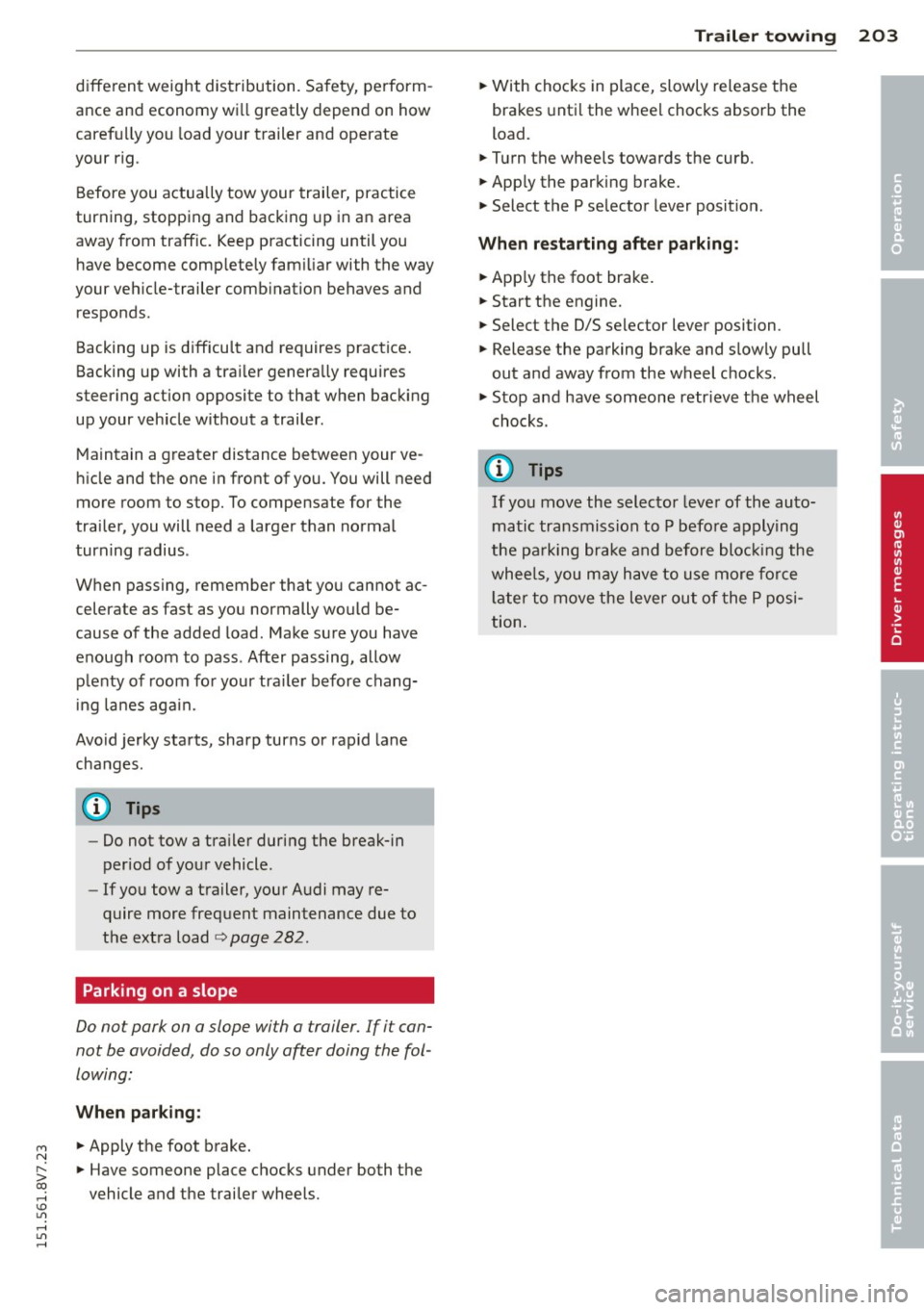
M N
" > co ,...., \!) 1.1"1 ,...., 1.1"1 ,....,
different weight distribution. Safety, perform
ance and economy wi ll greatly depend on how
carefu lly you load your trailer and operate
your rig.
Before you actually tow your trailer, practice
turning, stopping and backing up in an area
away from traffic. Keep practicing until you
have become comp letely familiar with the way
your vehicle- trailer combination behaves and
responds .
Backing up is d ifficult and requires practice.
Backing up with a trai ler generally requires
stee ring action opposite to that when backing
up your vehicle without a trailer .
Maintain a greater distance between your ve
hicle and the one in front of you. You will need
more room to stop. To compensate for the
trailer, you will need a larger than normal
turn ing radius.
When passing, remember that you cannot ac
celerate as fast as you normally would be
cause of the added load. Make sure you have
enough room to pass . After passing, allow
p lenty of room for your tra iler before chang
ing lanes again.
Avoid jerky starts, sharp turns or rapid lane
changes.
(D Tips
- Do not tow a tra iler during the break-in
period of your vehicle.
- If you tow a trailer, your Audi may re
quire more frequent maintenance due to
the extra load
¢ page 282 .
Parking on a slope
Do not park on a slope with a trailer. If i t can
not be avoided, do so only after doing the fol
lowing:
When parking:
.. Apply the foot brake.
.. Have someone place chocks under both the
vehicle and the trailer wheels.
Trailer towing 203
.. With chocks in place, slowly release the
brakes until the wheel chocks absorb the
load .
.. Turn the wheels towards the curb.
.. Apply the parking brake.
.. Select the P selector lever posit ion.
When re starting after parking:
.. App ly the foot brake.
.. Start the engine.
.. Select the
0/5 selector lever position.
.. Release the parking brake and slowly pull
out and away from the wheel chocks .
.. Stop and have someone retr ieve the wheel
chocks.
(D Tips
If you move the selector lever of the auto
matic transmission to
P before applying
the parking brake and before blocking the
whee ls, you may have to use more force
lat er to move the lever out of the
P posi
tion.
•
•
•
Page 206 of 302
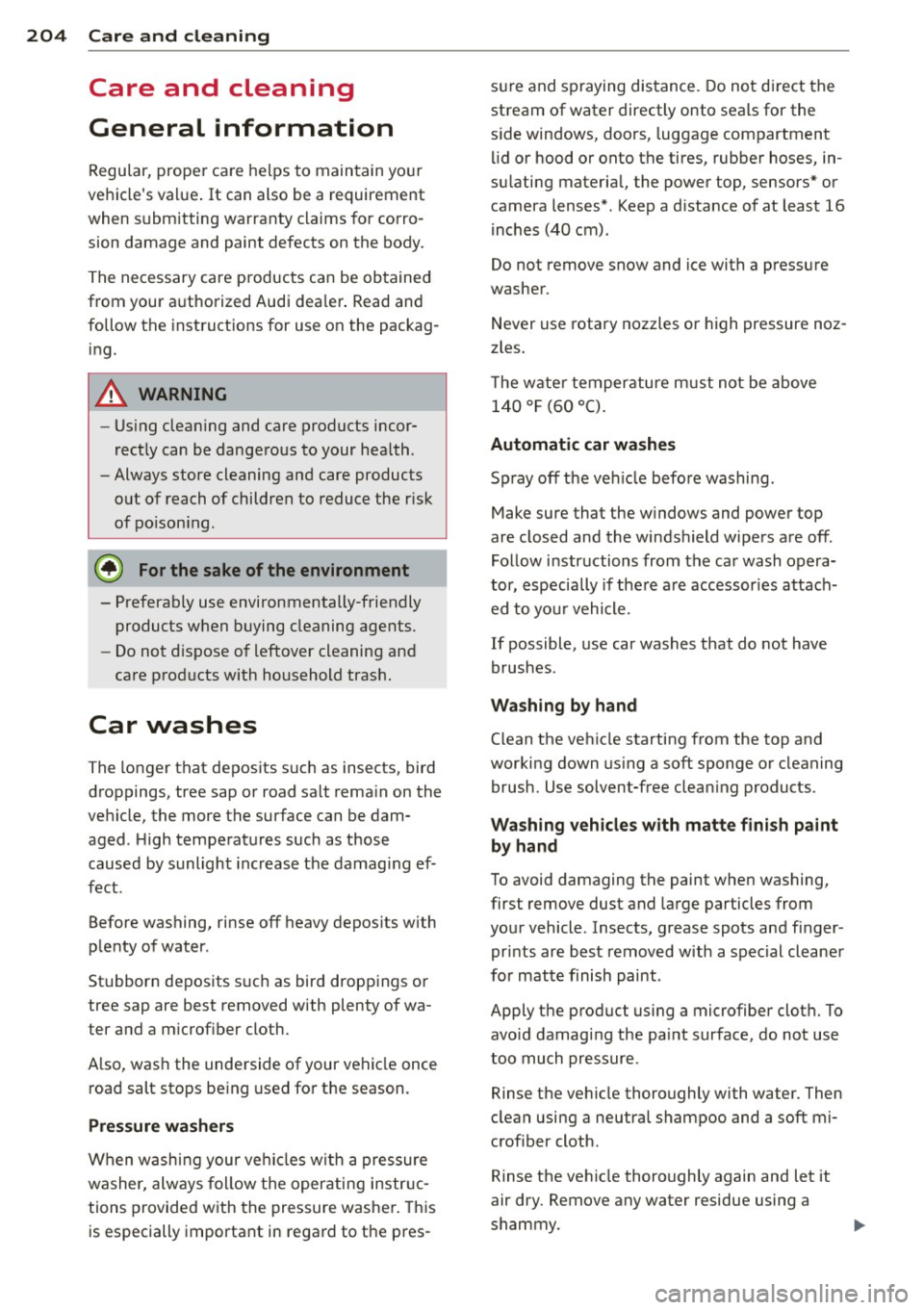
204 Care and cleaning
Care and cleaning
General information
Regular, prope r care helps to maintain your
vehicle's val ue . It can also be a requirement
when submitting warranty claims for corro sion damage and paint defects on the body.
The necessary care products can be obtained
from your authorized Audi dea ler . Read and
follow the instructions for use on the packag
ing.
A WARNING
- Us ing clean ing and care products incor
rect ly can be dangerous to your hea lth.
- Always store cleaning and care products
out of reach of children to reduce the r isk
of po ison ing.
-
@ For the sake of the environment
- Preferably use environmentally-friendly
products when buying cleaning agents.
- Do not d ispose o f leftover cleaning and
care p rod ucts with household trash.
Car washes
The longer that deposits such as insects, bird
droppings, tree sap or road salt rema in on the
ve hicle, the more the surface can be dam
aged . High temperatures such as those
caused by sunlight inc rease the damag ing ef
fect .
Before washing, rinse
off heavy depos its with
p lenty of water .
Stubborn deposits s uch as bird droppings or
tree sap are best removed with plenty of wa
ter and a m icrofiber cloth.
A lso, was h the underside of your vehicle once
road salt stops be ing used for the season.
Pressure washers
When w ash ing your ve hicl es w ith a pressure
washer, always follow the oper ating instr uc
tions provided with the pressure washer. This is especially important in rega rd to the p res- sure and sp
raying distance. Do not di rect the
stream of water directly onto seals for the
s ide windows, doors, luggage compartment
li d or hood or onto the tires, rubber hoses, in
su lating materia l, the power top, sensors* or
camera lenses*. Keep a d istance of at least 16
i nches (40 cm) .
Do not remove snow and ice with a pressure
washer.
Never use rotary nozzles or high pressure noz
zles .
T he wate r temperature m ust not be above
140
° F (60 °().
Automat ic car washes
Sp ray off the veh icle befo re washing.
Make sure that the w indows and power top
are closed and the winds hield wipers are
off.
Follow instructions from the ca r wash opera
tor, especially if the re a re accessories attach
ed to yo ur vehicle.
If possible, use car washes that do not have
brushes .
Washing by hand
Clean the veh icle starting from the top and
working down using a soft sponge or cleaning
brush. Use solvent-free clean ing products .
Washing vehicle s with matte fini sh paint
by hand
To avoid damaging the paint when washing,
first remove dust and large particles from
your vehicle. Insects, grease spots and fi nger
pri nts are best removed with a special cleane r
fo r matte finish paint .
Apply the prod uct us ing a microfiber cloth. To
avo id damag ing the pa int surface, do not use
too much pressure .
Rinse the vehicle thoroughly with water. Then
clean using a neutral shampoo and a soft mi
c rofiber cloth.
Rinse the vehicle thoroughly again and let it
air dry. Remove any water residue using a
shammy.
Page 276 of 302
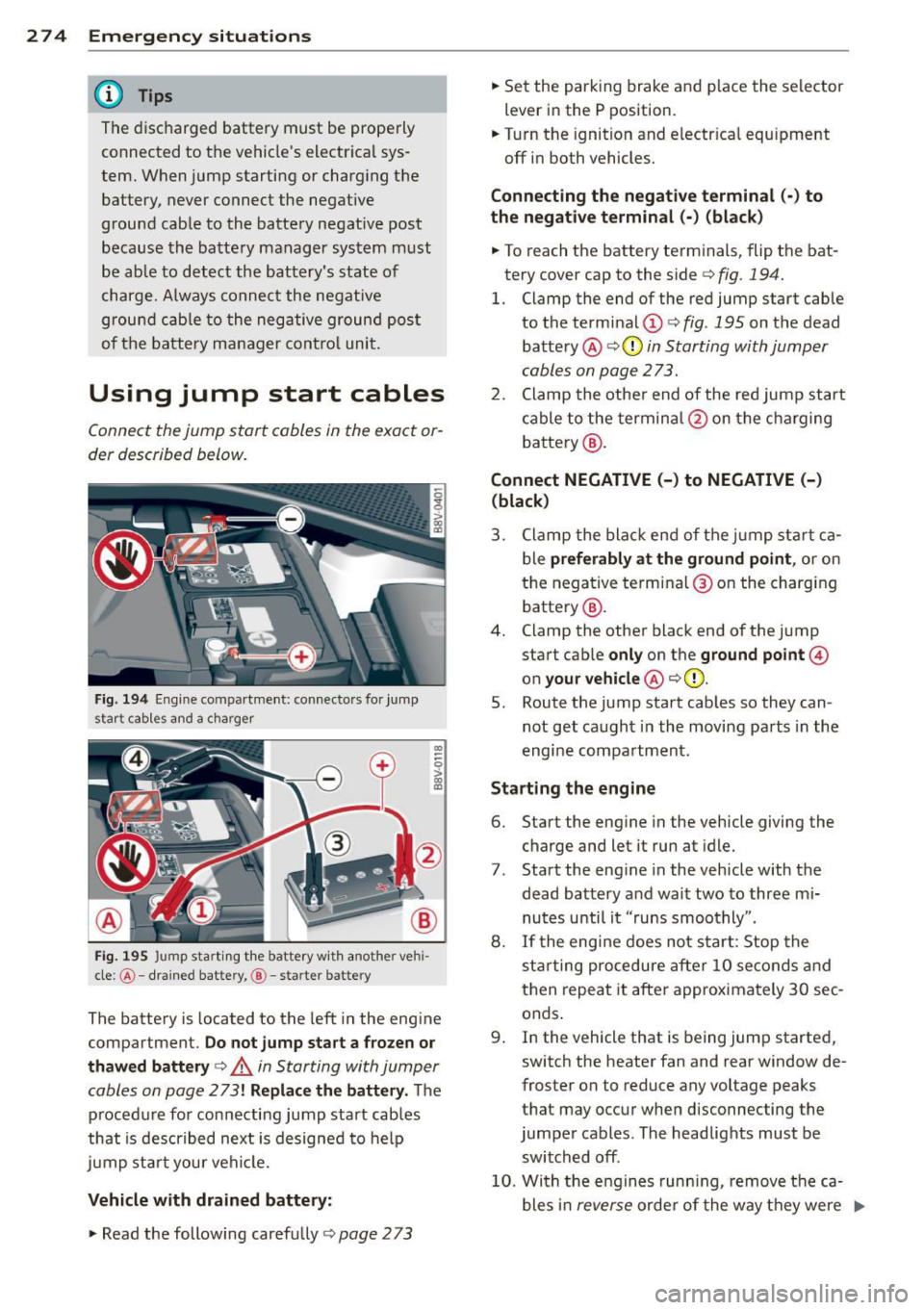
2 7 4 Emergency situations
@ Tips
The discharged battery must be properly
connected to the vehicle's electrical sys
tem. When jump starting or charging the
battery, never connect the negative
ground cable to the battery negative post
because the batte ry manager system must
be able to detect the battery 's state of
charge. Always connect the negative
ground cab le to the negative ground post
of the battery manager control unit.
Using jump start cables
Connect the jump start cables in the exact or
der described below.
Fig. 194 Engine compartment: connecto rs fo r jump
start cab les and a charger
Fig. 195 Jump sta rting the battery with another ve hi
cle :@ -drained battery, @-starte r battery
CD
--0 > ~
The battery is located to the left in the engine
compartment.
Do not jump start a frozen or
thawed battery¢
,A in Starting with Jumper
cables on page
273! Replace the battery. The
procedure for connecting jump start cables
that is described next is designed to help
jump start your vehicle.
Vehicle with drained battery:
.. Read the following carefully ¢ page 2 73
.. Set the parking brake and place the selector
lever in the P position.
.. Turn the ignition and electr ical equipment
off in both vehicles.
Connecting the negative terminal(·) to
the negative terminal (-) (black)
.. To reach the battery terminals, flip the bat
tery cover cap to the side¢
fig. 194.
l. Clamp the end of the red jump start cable
to the terminal (!)¢
fig. 195 on the dead
battery @¢0
in Starting with Jumper
cables on page 273.
2. Clamp the other end of the red jump start
cable to the terminal @on the charging
battery @.
Connect NEGATIVE (-) to NEGATIVE (-)
(black)
3. Clamp the black end of the jump start ca
ble
preferably at the ground point, or on
the negative terminal@on the charging
battery @.
4. Clamp the other black end of the jump
start cab le
only on the ground point@
on your vehicle @¢(D.
5. Route the jump start cables so they can
not get caught in the moving parts in the
engine compartment .
Starting the engine
6. Start the engine in the vehicle giving the
charge and let it run at idle.
7 . Start the engine in the vehicle with the
dead battery and wait two to three mi nutes until it "runs smoothly" .
8.
If the engine does not start: Stop the
starting procedure after
10 seconds and
then repeat it after approximately
30 sec
onds .
9 . In the vehicle that is being jump started,
switch the heater fan and rear window de
froster on to reduce any voltage peaks
that may occur when disconnecting the
jumper cables. The headlights must be
switched off .
10. With the engines running, remove the ca
bles in
reverse order of the way they were ..,.
Page 291 of 302
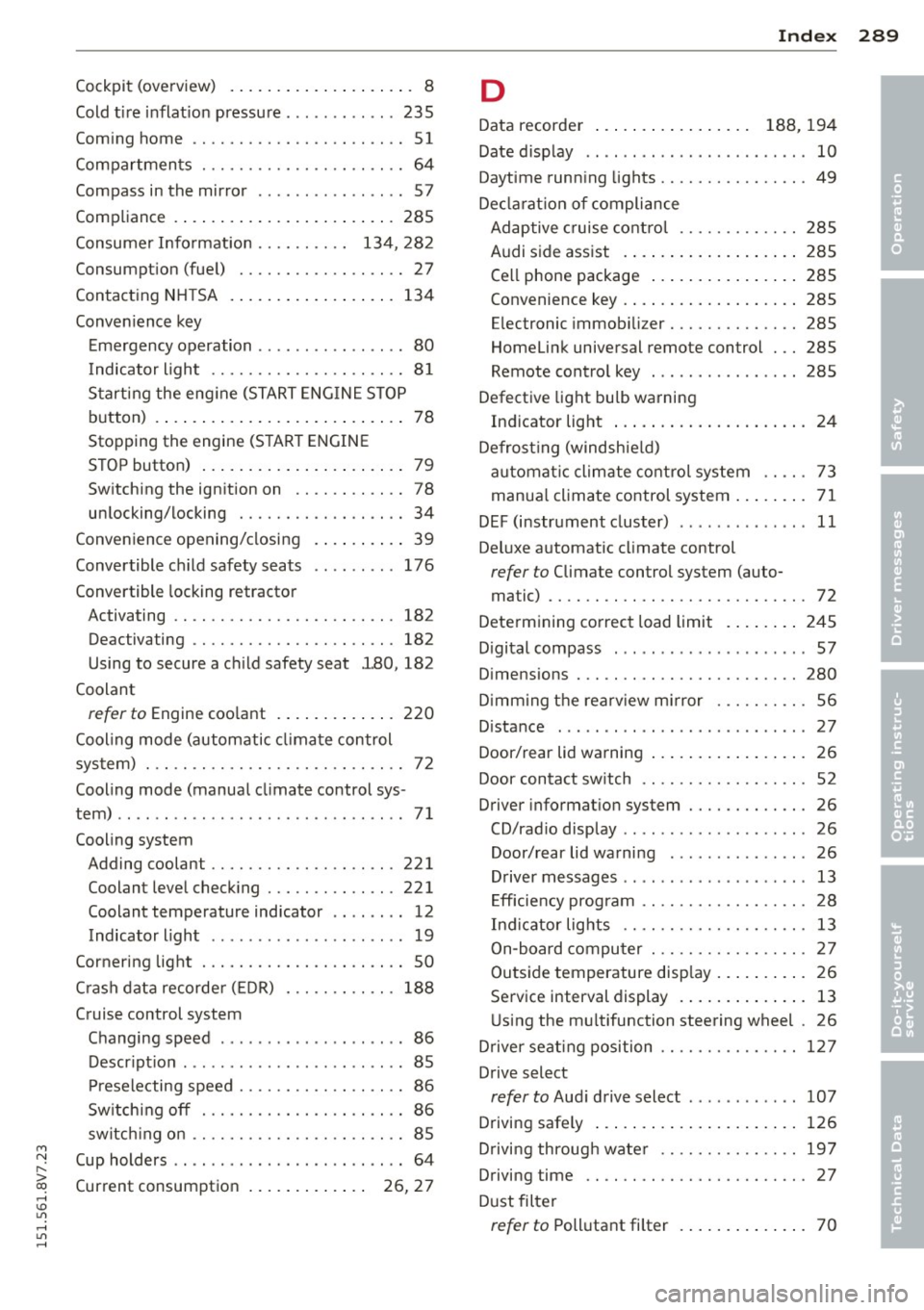
M N ,....
> co ,...., \!) 1.1'1 ,...., 1.1'1 ,....,
Cockpit (overview) . . . . . . . . . . . . . . . . . . . . 8
Cold tire inflation pressure ............ 235
Coming home ...... ..... .. .... .. .. .. 51
Compartments ............ .... .. .. .. 64
Compass in the mirror ........... .... . 57
Compliance .. .. .............. ... ... 285
Consumer Information . . . . . . . . . . 134, 282
Consumption (fuel) ........ .. .. .. .. .. 27
Contacting NH TSA ............ ... .. . 134
Convenience key Emergency operation . . . . . . . . . . . . . . . . 80
Indicator light ........... .. .. .. .. .. 81
Starting the engine (START ENGINE ST OP
button) .... .. .............. ... .... 78
Stopping the engine (S TART ENGINE
STOP button) . . . . . . . . . . . . . . . . . . . . . . 79
Switching the ignition on .. .. .. .. .. .. 78
unlocking/locking ........ .. .. .. .. .. 34
Convenience opening/closing
Convertible child safety seats
Convertible locking retractor .
. .. .. .. .. 39
176
Activating .. ................. .. .. . 182
Deactivating . . . . . . . . . . . . . . . . . . . . . . 182
Using to secure a child safety seat l80, 182
Coolant
refer to Engine coolant ....... ... .. . 220
Cool ing mode (automatic climate control
system) . .. .. ................. .. .. .. 72
Cooling mode (manual climate control sys-
tem) .. .. .. .. .. ........ ... .. .. .. .. .. 71
Cooling system Adding coolant ........... .... .. .. . 221
Coolant level checking ..... .. .. .. .. . 221
Coolant temperature indicator .. ... ... 12
Indicator light ... .. ...... .. .. .. .. .. 19
Cornering light . ........... .. .. .. .. .. 50
C rash data recorde r (EDR) 188
Cruise control system Changing speed . . . . . . . . . . . . . . . . . . . . 86
Description ............... ... ... ... 85
Preselecting speed . . . . . . . . . . . . . . . . . . 86
Sw itching off . ........... .. .. .. .. .. 86
switch ing on ............. .... .. .. .. 85
Cup holders . . . . . . . . . . . . . . . . . . . . . . . . . 64
Current consumption . . . . . . . . . . . . . 26, 27
Index 289
D
Data recorder . . . . . . . . . . . . . . . . . 188, 194
Date display . . . . . . . . . . . . . . . . . . . . . . . . 10
Daytime running lights ........... .... . 49
Decla rat ion of compliance
Adaptive cruise control . . . . . . . . . . . . . 28S
Audi side assist .... .............. . 285
Cell phone package . . . . . . . . . . . . . . . . 285
Convenience key .... .............. . 285
Electronic immobilizer .......... .. .. 285
Homelink universal remote control . .. 285
Remote control key . . . . . . . . . . . . . . . . 285
Defective light bulb warning
Indicator light ... .. ................ 24
Defrost ing (windshield)
automat ic climate control system . . . . . 73
manual climate control system ........ 71
DEF (instrument cluster) ... .. .... .... . 11
Deluxe automatic climate control
refer to Climate control system (auto-
ma tic) ...... .. .. .. . ............... 72
Determining correct load limit ....... . 245
Digital compass . .. .. . ............ .. . 57
Dimensions . .. .. .. ................. 280
D imming the rearv iew mirror ..... .. .. . 56
Distance ......... .. ..... ........... 27
Door/rear lid warning 26
Door contact sw itch . . . . . . . . . . . . . . . . . . 52
Driver information system .......... .. . 26
CD/radio display .. .. . .. .. .. .... .... . 26
Door/rear lid warning ............... 26
Driver messages . . . . . . . . . . . . . . . . . . . . 13
Efficiency program . . . . . . . . . . . . . . . . . . 28
Ind icator lights .. .... ......... .... . 13
On-board computer ............ .. .. . 27
Outside temperature display . . . . . . . . . . 26
Service interval display . . . . . . . . . . . . . . 13
Using the mu ltifunction steering wheel . 26
Driver seating position ........... .... 127
Drive select
refer to Audi drive select ............ 107
Driving safely 126
Driving through water .. ......... .. .. 197
Driving time
Dust filter 27
refer to Pollutant
filter ............ .. 70
•
•
Page 292 of 302

290 Index
E
ECO mode (automatic climate control sys -
tem) . ..... .. ................ ..... ..
72
Efficiency program . . . . . . . . . . . . . . . . . . . 28
Description .............. .... .. .. .. 28
Fu el economy messages . . . . . . . . . . . . . 29
Other equipment . . . . . . . . . . . . . . . . . . . 29
Electrical accessor ies
refer to Socket . . . . . . . . . . . . . . . . . . . . . 64
Electromechanical parking brake
refer to Parking brake ......... .... .. 82
Electromechanical steering ....... ... . 192
Indicator lights ................... 192
Electronic diffe rent ial loc k ... .. .. .. .. . 188
Indicator light . . . . . . . . . . . . . . . . . . . . . 21
Electronic immobilizer ...... .... .... .. 36
also refer to Immobilizer . . . . . . . . . . . . 31
Electronic speed limiter . . . . . . . . . . . . . . . 30
Electronic stabilization control (ESC)
I ndicator light . . . . . . . . . . . . . . . . . . . . .
21
Sport mode ................ ..... . 189
Electronic Stabilization Control (ESC) . . . 188
Emergency assistance ....... ... .... . 261
Emergency flasher . . . . . . . . . . . . . . . . . . . 50
Emergency flashers
Indicator light . . . . . . . . . . . . . . . . . . . . .
25
Emergency operation
Emergency braking function .... .... ..
84
Front passenger's door ...... .. .. .. . . 37
Luggage compartment lid .. .... .... . 261
Power top . . . . . . . . . . . . . . . . . . . . . . . . . 45
·th ' k
w1 convenience ey . . . . . . . . . . . . . . . . 80
Emergency release
Fuel filler door ........... .........
213
Selector lever . . . . . . . . . . . . . . . . . . . . . 117
Emergency starting ......... ... .... . 273
Emergency towing ... .. .... .. .. .. .. . 275
Energy management ....... .. .. .. .. . 193
Indicator light . . . . . . . . . . . . . . . . . . . . . 20
Engine
Coolant
.. .. ................ ..... . 220
Starting with jumper cables . ..... .. . 273
starting (button) ............. .... .. 78
Starting (driver messages with conven-
ience key) .. ........ ..... .. ........
81
start ing (key) . .. ...... .... ... .. .. .. 76
stopping (button) ............. ..... 79
stopping (key) ... ................ .. 78
Engine compartment
Closing the hood .............. .. ..
216
Open ing the hood ................. 215
Overview . ..... .. ................ . 216
Safety precautions ............. .... 214
Engine control (indicator light) ...... .. . 22
Engine coolant .. .. ............. .... 220
Radiator fan ... .. ... .......... .... 221
Engine oil . ..... .. ................ . 217
adding ....... .. ................ . 218
Changing ........................ 219
Checking the oil level ............... 218
Dipstick. .. .. .. .. ............ 216, 218
Indicator light . .. ... ......... ... .. . 20
Oil consumption .. ..... ..... ... .. .. 217
Specification and viscosity ... .. .. .. .. 217
Use ...... .... ................... 218
Engine speed limitation (indicator light) . 23
Environment
Break-in period . . . . . . . . . . . . . . . . . . . .
196
Catalytic converter ............. .. .. 197
Disposing of your vehicle battery . .. .. 226
Driving at high speeds ............ .. 198
Driving to minimize pollution and noise 198
Fuel economy . ... ....... ...... .. .. 198
Letting the vehicle stand and warm up. 199
Proper disposal of drained brake fluid . 222
Proper disposal of drained eng ine oil .. 219
Unleaded fuel .... ................ . 210
What should I do with an o ld battery? . 226
EPC (engine contro l) . . . . . . . . . . . . . . . . . . 22
ESC
Automatic post-collision braking sys-
tem .. ... ... .. .. .. ...... ....... ..
189
Electronic stabilizat ion control . .. .. .. 188
Sport mode . .. .. ... ....... ... .. .. 189
Event Data Recorder (EDR) . . . . . . . . . . . . 194
Exterior lighting . .. ... .......... ..... 49
Exterior m irrors
Adjusting . . . . . . . . . . . . . . . . . . . . . . . . .
55
D. . 1mming .. .. ...... .. ... ... ... ..... 56
folding ... ................... ..... 55
Heating . .. ................... .... . 55
Page 296 of 302
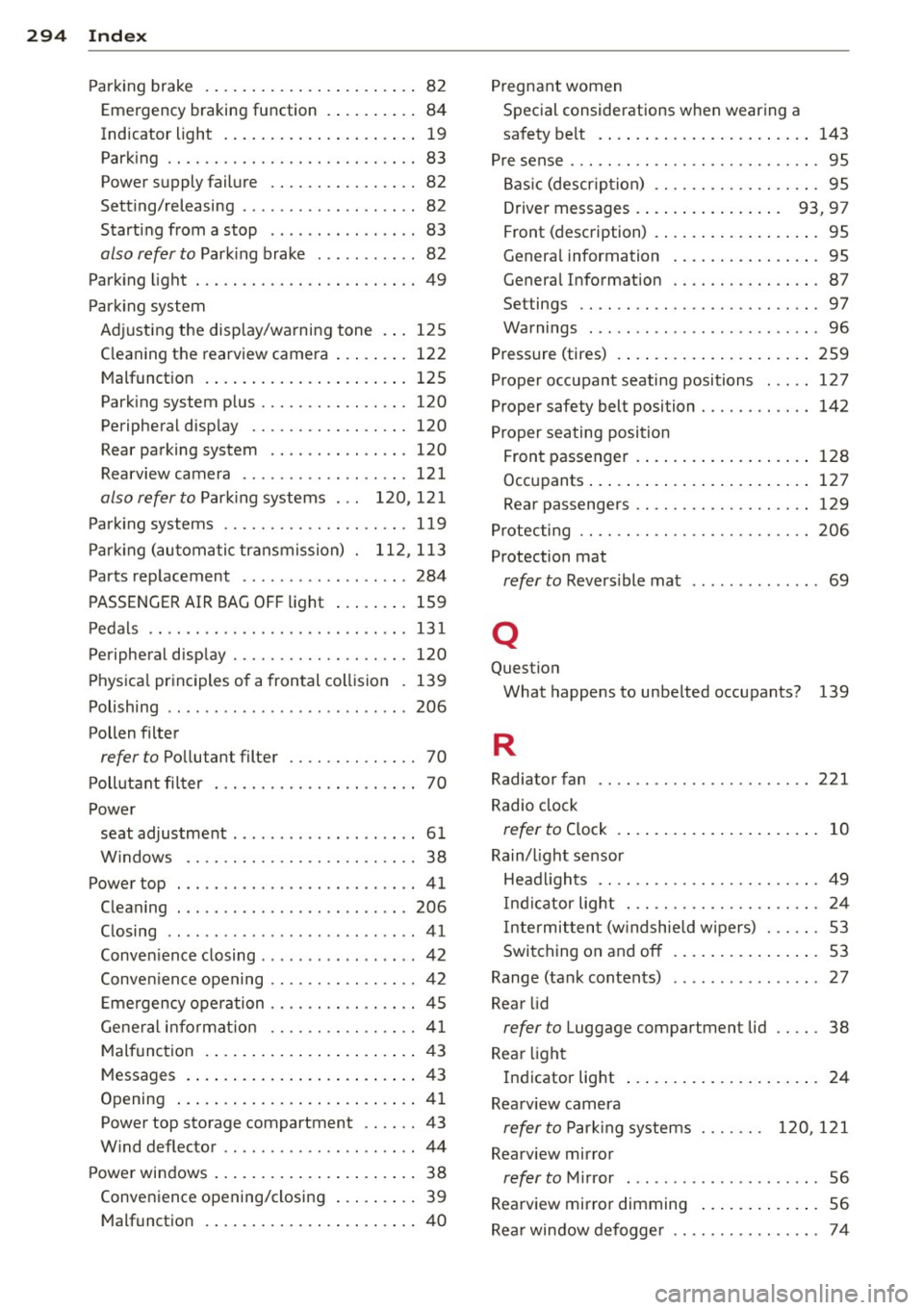
29 4 Index
Parking brake .......... ... .. .. .... .. 82
Emergency braking function . ..... .. .. 84
Indicator light ............ ... .... .. 19
Parking .. ............... ........ .. 83
Power supply failure .............. .. 82
Setting/releasing . . . . . . . . . . . . . . . . . . . 82
Starting from a stop ...... .. .. .. .. . . 83
also refer to Parking brake ........... 82
Parking light ... ............ ... .... .. 49
Park ing system
Adjusting the disp lay/warning tone ... 125
C leaning the rearview camera ..... .. . 122
Malfunction .............. ... .... . 125
Parking system plus ................ 120
Peripheral display . . . . . . . . . . . . . . . . . 120
Rear parking system ........... .... 120
Rearview camera .......... .... ... . 121
also refer to Park ing systems . . . 120, 121
Parking systems ............ ... .... . 119
Park ing (automatic transmission) . 112, 113
Parts replacement ............. .. ... 284
PASSENGER AIR BAG OFF light ....... . 159
Pedals .. .. ... ............ .. .. .. .. . 131
Peripheral display . . . . . . . . . . . . . . . . . . . 120
Physica l principles of a frontal collis ion . 139
Polishing .. .. ... .... ...... ...... .. . 206
Pollen filter
refer to Pollutant filter . . . . . . . . . . . . . . 70
Poll utant filter ...................... 70
Power seat adjustment ............... ..... 61
W indows .. .......... ......... .. .. 38
Power top ..... ............ ... .... .. 41
Cleaning . ... ... .......... ... .. ... 206
Closing .. .. ................ ... .... 41
Conven ience closing ............ ..... 42
Conven ience opening ................ 42
E mergency operation . . . . . . . . . . . . . . . . 45
General informat ion ................ 41
Malfunction .............. ... .... .. 43
Messages .. ................ ..... .. 43
Opening ... ................ ..... .. 41
Power top storage compartment .. .... 43
Wind deflector ............ ... .... .. 44
Power windows . . . . . . . . . . . . . . . . . . . . . . 38
Convenience opening/closing . . . . . . . . . 39
Malfunction .............. ... .... .. 40 Pregnant
women
Special considerations when wearing a
safety belt . . . . . . . . . . . . . . . . . . . . . . . 143
Pre sense ........................... 95
Bas ic (description) ............. .... . 95
Driver messages . . . . . . . . . . . . . . . . 93, 97
Front (description) ................ .. 95
General information ............ ... . 95
General Information ........... .. .. . 87
Settings .......................... 97
Warnings ....... ................. . 96
Pressure (tires) .... ................ . 259
Proper occupant seating positions ..... 127
Proper safety belt position . . . . . . . . . . . . 142
Proper seating position Front passenger .. ................ . 128
Occupants ..... .. .. .............. . 127
Rear passengers . . . . . . . . . . . . . . . . . . . 129
Protecting .. .. .. .. ............. .... 206
Protection mat
refer to Revers ible mat ............ .. 69
Q
Question
What happens to unbelted occupants? 139
R
Radiator fan
221
Radio clock
refer to Clock . . . . . . . . . . . . . . . . . . . . . . 10
Rain/light sensor Headlights ...... ............. ..... 49
Indicator light ... ............. .... . 24
Intermittent (w indshield w ipers) ...... 53
Switching on and off ................ 53
Range (tank contents) .............. .. 27
Rear lid
refer to Luggage compartment lid .. .. . 38
Rea r light
Indicator light ... ................ .. 24
Rearv iew camera
refer to Park ing systems 120,121
Rearview mirror
refer to Mirror ... ... .... ........ .. . 56
Rearview mirror dimming ........ ... .. 56
Rear window defogger ................ 74
Page 298 of 302
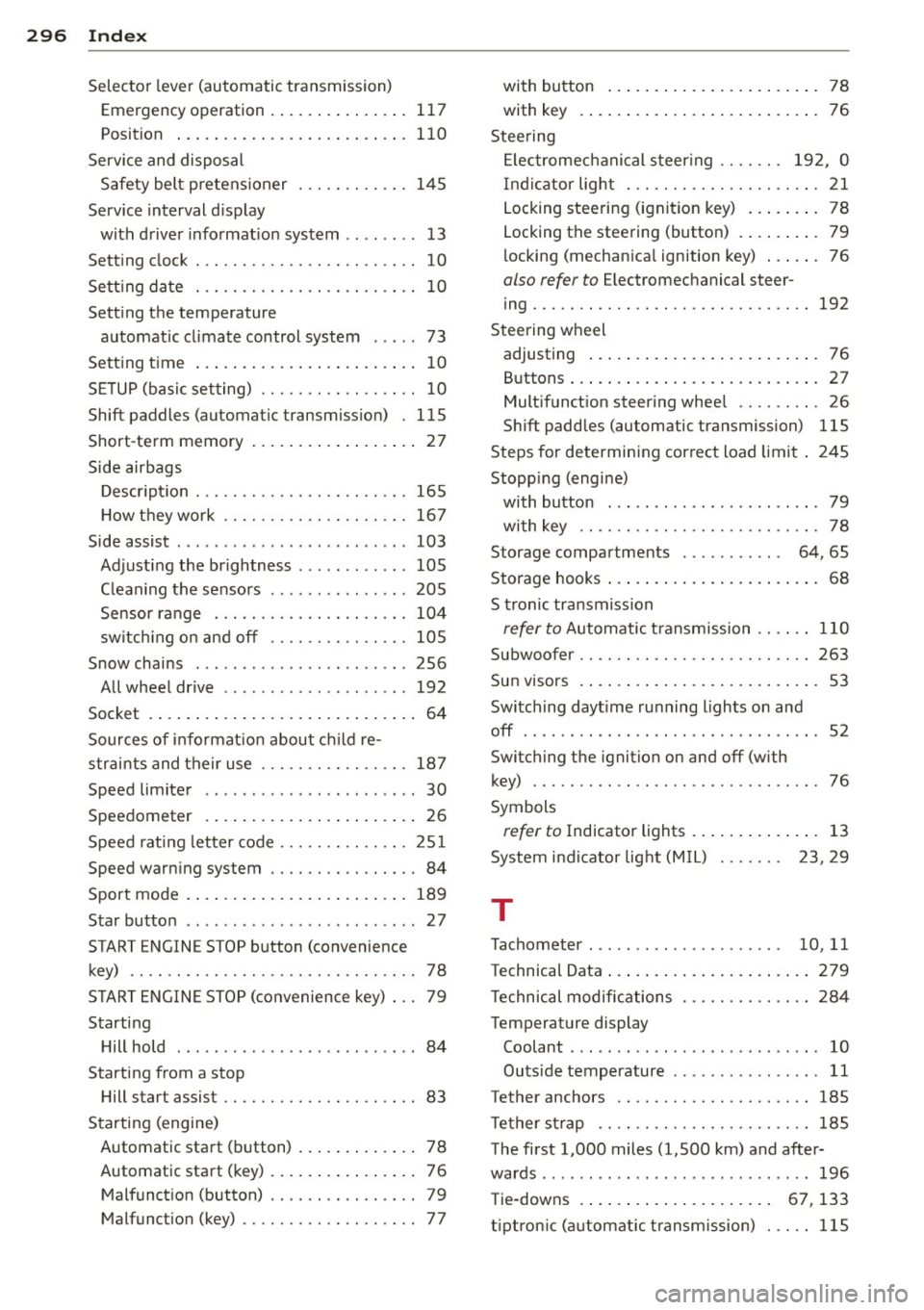
296 Index
Selector lever (automatic transmission)
Emergency operation . . . . . . . . . . . . . . . 117
Position ... ................ ..... . 110
Service and disposal
Safety belt p retens ioner ... .. .. .... . 145
Service interval display
with driver informat ion system .. .. .... 13
Setting clock ................ .. .... .. 10
Sett ing date ............ .. .. .. .. .. .. 10
Setting the temperature automatic climate control system ... . . 73
Setting time ............... ... .... .. 10
SETUP (basic setting) ......... .. .... .. 10
Shift paddles (automatic transmission) . 115
Short-term memory ................ .. 27
Side airbags
Description ............ .. .. .. .. .. . 165
H ow they work ........... .. .. .... . 167
Side assist . .. ..... ........... ... .. . 103
Adjust ing the brightness ..... .. .. .. . 105
Cleaning the sensors .......... .. ... 205
Sensor range . ........... .... .... . 104
switch ing on and off .... .. .. .. .. .. . 105
Snow chains ........... .... ... .. .. . 256
All wheel drive ............ ... .. .. . 192
Socket . ..... ................ ..... .. 64
Sources of information about child re-
straints and their use ....... .. .. .. .. . 187
Speed limiter . . . . . . . . . . . . . . . . . . . . . . . 30
Speedometer . . . . . . . . . . . . . . . . . . . . . . . 26
Speed rating letter code ..... .. .. .. .. . 251
Speed warning system ...... .. .. .. .. . . 84
Sport mode . ............... ... .... . 189
Star button .. ... .... ...... .. .. .. .. .. 27
STAR T ENGIN E STOP button (convenience
key) .. .. .. .. .. . .......... .. .. .... .. 78
START ENGINE STOP (convenience key) ... 79
Starting Hill hold . .. ................ ... .. .. 84
Starting from a stop Hill start assist ........... .. .. .... .. 83
Starting (engine)
Automatic start (button) ....... .... . . 78
Automatic start (key) ....... .... ... .. 76
Malfunction (button) . . . . . . . . . . . . . . . . 79
Malfunction (key) . . . . . . . . . . . . . . . . . . . 77 with button
. . . . . . . . . . . . . . . . . . . . . . . 78
with key . ..... .. .. .............. .. 76
Steering Electromechanical steering . . . . . . . 192, 0
Indicator light ... ............. .... . 21
Locking steering (ignition key) ........ 78
Locking the steering (button) . . . . . . . . . 79
locking (mechanica l ignition key) ...... 76
also refer to Electromechanical steer-
ing ... .... .... ................... 192
Steering wheel
adjusting . . . . . . . . . . . . . . . . . . . . . . . . . 76
Buttons ....... .. ............. ..... 27
Multifunction steering wheel .... .. .. . 26
Shift paddles (automatic transmission) 115
Steps for determining correct load limit . 24S
Stopping (engine) with button . . . . . . . . . . . . . . . . . . . . . . . 79
with key .. .... .. ............. .... . 78
Storage compar tments . . . . . . . . . . . 64, 6S
Storage hooks . . . . . . . . . . . . . . . . . . . . . . . 68
S tronic transmission
refer to Automatic transmission .. .. .. 110
Subwoofer .. .. .. .. ............. .. .. 263
Sun visors . ..... .. ................ .. 53
Switch ing daytime running lights on and
off .. .. .. .. .. .. .. .... ...... ... .. .. . 52
Switching the ignition on and off (with
key) ... .... .... ................... . 76
Symbols
refer to Indicator lights . . . . . . . . . . . . . . 13
System indicator light (M IL) . . . . . . . 23, 29
T
Tachometer . . . . . . . . . . . . . . . . . . . . . 10, 11
Technical Data ..... ................ . 279
T echnical modifications ............ .. 284
Temperature display Coolant ....... .. .. ........ ...... .. 10
Outs ide temperature . . . . . . . . . . . . . . . . 11
Tether anchors .. .. ............. .... 185
T ether strap .. .. .. ............. .. .. 185
The first 1 ,000 miles (1,SOO km) and after-
wards ......... ... .. .............. . 196
Tie-downs . . . . . . . . . . . . . . . . . . . . . 67, 133
t ip tron ic (automatic transmission) ..... 115